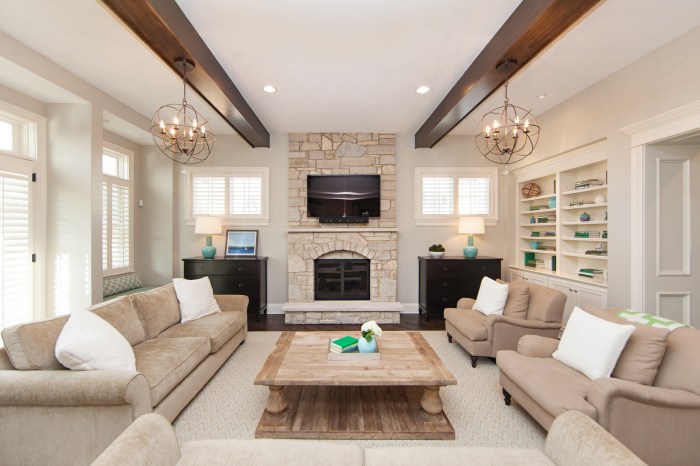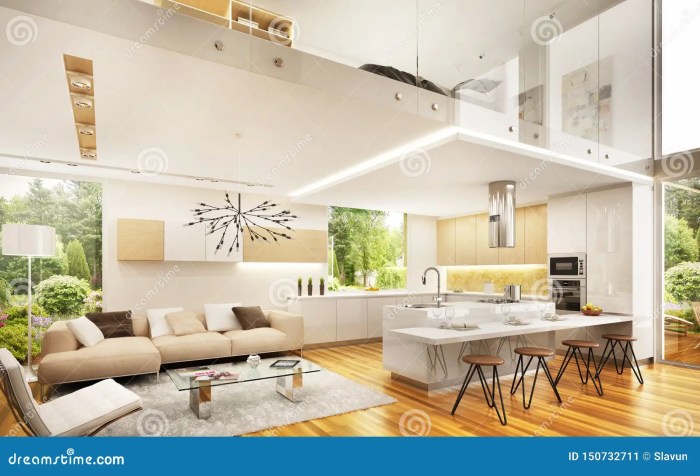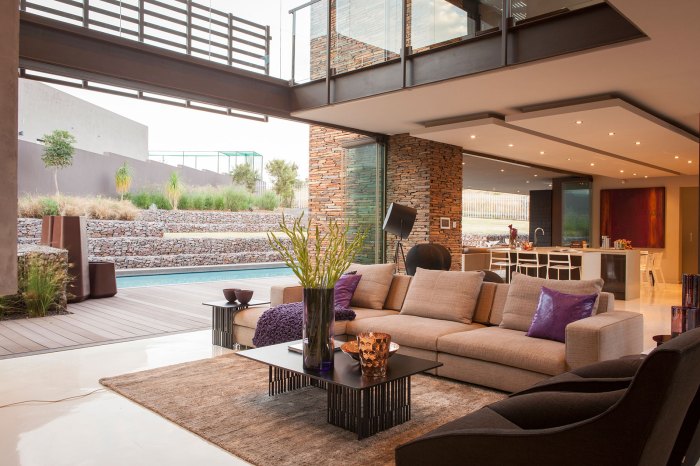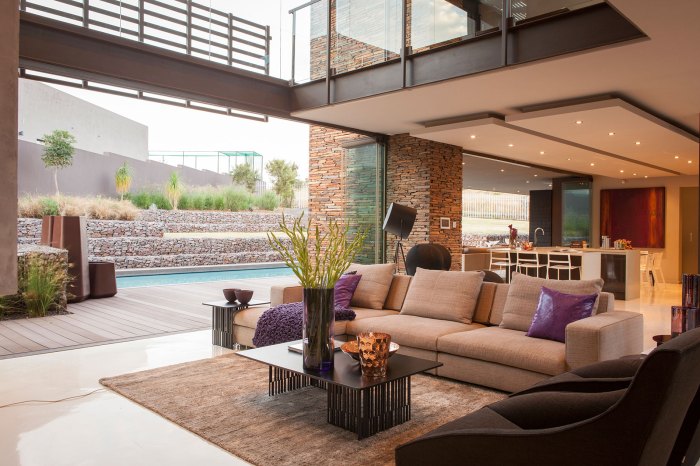Big house interior design sets the stage for a unique set of challenges and rewards. While the grandeur of expansive spaces offers a canvas for creativity, it also demands careful consideration of scale, flow, and functionality. Designing for a large home requires a keen eye for proportion, a deep understanding of space planning, and the ability to blend style with practicality.
From maximizing natural light and breathtaking views to selecting furniture that complements the architecture, every decision plays a crucial role in shaping the overall atmosphere of a big house. The goal is to create a cohesive and inviting environment that balances grandeur with intimacy, seamlessly integrating every element into a harmonious whole.
Selecting Furniture and Furnishings

Furnishing a large house presents a unique set of challenges and opportunities. The sheer size of the space necessitates careful consideration of scale, proportion, and style to create a cohesive and inviting environment.
Choosing Furniture That Fits the Space
The size of the furniture is crucial in a big house. Oversized furniture can overwhelm a room, while small pieces can get lost in the vastness. It is important to strike a balance between pieces that are large enough to fill the space and small enough to maintain a sense of intimacy.
Designing the interior of a large house presents a unique set of challenges, as you have to consider the scale and flow of the space. One approach that works well for big houses is incorporating elements of arts and crafts house interior design , which emphasizes natural materials, handcrafted details, and a sense of warmth and comfort.
This style can create a cohesive and inviting atmosphere throughout a large home, even in spaces that might otherwise feel overwhelming.
The proportion of furniture pieces should also be considered, ensuring that they are in harmony with the overall dimensions of the room. A large sofa, for example, might require a similarly sized coffee table to maintain visual balance.
Creating a Furniture Layout Plan
A furniture layout plan is essential for visualizing how the furniture will be arranged in a large living room. This plan should take into account the flow of traffic, the placement of focal points, and the overall aesthetic. A typical layout for a large living room might include:* A large sectional sofa or multiple sofas arranged in a conversational grouping
- A coffee table in the center of the seating area
- An entertainment center with a television
- A fireplace or other focal point
- Accent chairs and ottomans for additional seating
- Bookshelves or cabinets for storage and display
Complementing the Architectural Style
The furniture should complement the architectural style of the house and the overall design aesthetic. For example, a traditional house might be furnished with antiques and traditional upholstery, while a modern house might feature sleek, minimalist pieces. It is important to consider the style of the house and the desired ambiance when selecting furniture.
Creating a Sense of Intimacy and Warmth

A large house can sometimes feel cold and impersonal, lacking the cozy atmosphere that makes a home truly inviting. However, with careful planning and strategic design choices, you can infuse a sense of intimacy and warmth into even the grandest of spaces.
Creating Cozy Nooks and Breaking Up Large Spaces
To counteract the vastness of a large house, creating designated areas for specific activities is crucial. These designated spaces can be defined by furniture arrangement, rugs, or even subtle changes in floor levels. For example, a comfy seating area with plush armchairs and a fireplace can transform a large living room into a cozy gathering spot.
Similarly, a reading nook tucked away in a corner with a comfortable armchair and a bookshelf can provide a secluded retreat for quiet contemplation.
Designing the interior of a large house offers a wealth of possibilities, allowing for expansive spaces and elaborate decor. However, even in smaller dwellings, creative solutions can transform a space. For instance, apartment house interior design often incorporates clever use of mirrors and light to enhance the feeling of spaciousness, a technique that can be adapted to any size home.
Using Lighting to Create a Warm and Inviting Ambiance
Lighting plays a crucial role in setting the mood of a space. In a large house, it’s important to avoid harsh overhead lighting that can make the space feel sterile. Instead, opt for softer, layered lighting using a combination of ambient, task, and accent lighting.
Ambient lighting, like a dimmer switch on a chandelier or a string of fairy lights, provides overall illumination, while task lighting, such as a reading lamp or desk lamp, provides focused light for specific activities. Accent lighting, such as spotlights highlighting artwork or architectural details, adds depth and interest to the space.
Employing Textures and Colors to Foster a Welcoming Atmosphere, Big house interior design
The choice of textures and colors can significantly influence the overall feel of a large house. Warm, earthy tones like browns, creams, and yellows create a sense of comfort and coziness, while soft, muted hues can promote a sense of calm and serenity.
Using a variety of textures, such as plush rugs, soft throws, and textured fabrics, adds warmth and depth to the space. Incorporating natural elements like wood, stone, or greenery can further enhance the feeling of warmth and connection to nature.
Blending Style and Functionality

A big house offers ample space to create stunning interiors, but the challenge lies in making those spaces not only visually appealing but also practical and functional for daily living. Blending style and functionality is essential to ensure your big house feels welcoming, inviting, and truly serves its purpose.
Designing a big house interior often involves grand spaces and intricate details, but the same principles of functionality and aesthetics apply even in smaller homes. If you’re working with a more compact space, such as an 800 sq ft house, it’s essential to prioritize efficient use of space and choose furniture and decor that complements the overall design.
A well-planned layout can make a small home feel spacious and inviting, while a 800 sq ft house interior design can highlight the unique charm of a smaller footprint. Whether you’re working with a grand mansion or a cozy cottage, the goal is to create a comfortable and visually appealing living space.
Creating a Stylish and Functional Kitchen
The kitchen is the heart of the home, a space for cooking, gathering, and creating memories. Designing a kitchen that seamlessly blends style and functionality requires careful consideration of both aesthetics and practicality.
- Prioritize Functionality:Start by defining your kitchen needs. Consider your cooking habits, family size, and entertaining frequency. If you’re an avid cook, invest in high-quality appliances, ample counter space, and well-organized storage.
- Embrace a Cohesive Design:Choose a color palette and materials that complement the overall style of your home. A timeless kitchen design often incorporates neutral colors like white, gray, or beige, which provide a clean backdrop for pops of color through accents and accessories.
- Maximize Storage:A well-organized kitchen is a joy to work in. Utilize cabinets, drawers, and shelves to maximize storage space. Consider incorporating a pantry or a separate food storage area for larger items.
- Embrace Natural Light:Natural light brightens and enhances any space. Maximize natural light in your kitchen by incorporating large windows or skylights.
End of Discussion
Designing a big house interior is a journey of balancing grand scale with intimate details. By carefully considering the unique challenges and opportunities presented by large spaces, designers can create interiors that are not only visually stunning but also functional and inviting.
Whether it’s maximizing natural light, selecting furniture that complements the architecture, or creating a sense of warmth and intimacy, every decision plays a crucial role in shaping the overall atmosphere of a big house. The result is a space that is both grand and welcoming, reflecting the personality and lifestyle of its inhabitants.
Question Bank: Big House Interior Design
What are some common mistakes to avoid when designing a big house?
Common mistakes include neglecting scale and proportion, creating dead space, failing to consider natural light, and overlooking the importance of flow and functionality.
How can I make a large house feel cozy and inviting?
Use warm colors, soft textures, strategically placed lighting, and create cozy nooks and seating areas.
What are some tips for maximizing storage space in a big house?
Utilize built-in storage solutions, maximize vertical space, and consider using furniture with storage capabilities.
How do I create a cohesive design throughout a large home?
Choose a consistent color palette, use recurring design elements, and maintain a consistent style throughout the house.
